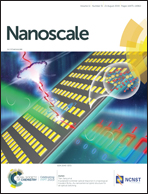Atomic structures of RNA nanotubes and their comparison with DNA nanotubes†
Abstract
We present a computational framework to model RNA based nanostructures and study their microscopic structures. We model hexagonal nanotubes made of 6 dsRNA (RNTs) connected by double crossover (DX) at different positions. Using several hundred nano-second (ns) long all-atom molecular dynamics simulations, we study the atomic structure, conformational change and elastic properties of RNTs in the presence of explicit water and ions. Based on several structural quantities such as root mean square deviation (RMSD) and root mean square fluctuation (RMSF), we find that the RNTs are almost as stable as DNA nanotubes (DNTs). Although the central portion of the RNTs maintain its cylindrical shape, both the terminal regions open up to give rise to a gating like behavior which can play a crucial role in drug delivery. From the bending angle distribution, we observe that the RNTs are more flexible than DNTs. The calculated persistence length of the RNTs is in the micron range which is an order of magnitude higher than that of a single dsRNA. The stretch modulus of the RNTs from the contour length distribution is in the range of 4–7 nN depending on the sequence. The calculated persistence length and stretch modulus are in the same range of values as in the case of DNTs. To understand the structural properties of RNTs at the individual base-pair level we have also calculated all the helicoidal parameters and analyzed the relative flexibility and rigidity of RNTs having a different sequence. These findings emphasized the fascinating properties of RNTs which will expedite further theoretical and experimental studies in this field.



 Please wait while we load your content...
Please wait while we load your content...